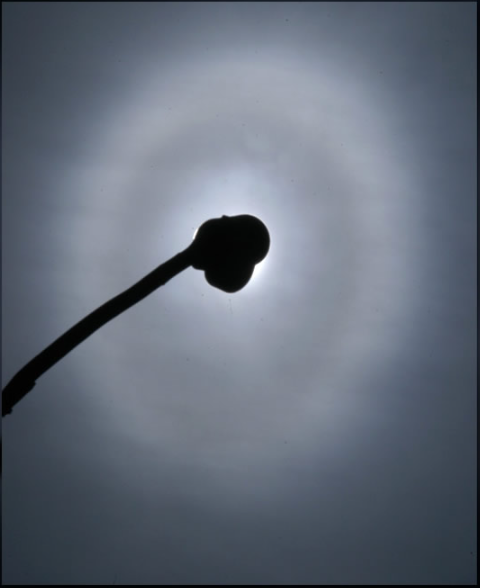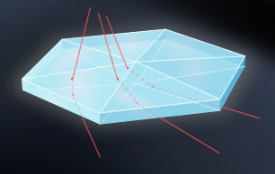Ohio Elliptical Halo
Ohio Elliptical Halo: A Rare and Mysterious Atmospheric Phenomenon
Have you ever heard of an elliptical halo? This fascinating atmospheric phenomenon is both rare and mysterious, captivating the attention of sky enthusiasts and researchers alike. In this article, we will delve into the intriguing world of elliptical halos, specifically focusing on an exceptional sighting that occurred over Ohio on March 23, '08.
A Captivating Image
The Ohio elliptical halo was captured by Michael Ellestad, a veteran halo observer and talented photographer. The image showcases the elliptical halo in all its glory, as it appeared in the altocumulus clouds for an astonishing two hours. The rarity and beauty of this sight cannot be overstated.
Unraveling the Mystery
Elliptical halos pose a puzzling challenge for scientists and researchers. While they can be simulated using ray tracing techniques, the crystals required to produce these halos are highly improbable in nature. The crystals would need to have extremely large apex angles, resulting in plate-like shapes that deviate from the more common pyramid-like crystals found in the atmosphere.
Crystallographic Unlikelihood
Crystal facets typically align themselves along simple, low-energy directions within the molecular lattice. This makes the formation of the necessary pyramidal crystals for elliptical halos crystallographically unlikely. The fact that such halos can still manifest in the sky suggests that there must be other factors at play.
Rings within Rings
One intriguing aspect of elliptical halos is their ability to exhibit two or three rings. These rings are formed when light rays pass between crystal faces with different interfacial angles. The resulting interference patterns create visually stunning rings that resemble those observed in actual halos. However, simulations have thus far been unable to fully replicate the complex nature of elliptical halos.
Beyond Simulations
While simulations provide valuable insights, they fall short in capturing the full complexity of elliptical halos. There is clearly more to these phenomena than meets the eye. Scientists and researchers continue to explore alternative explanations and delve deeper into the atmospheric conditions that give rise to these rare optical displays.
Observations and Documentation
The sighting of the Ohio elliptical halo serves as a reminder of the importance of keen observation and meticulous documentation. By capturing images and recording the details of such events, observers like Michael Ellestad contribute to our collective knowledge and understanding of atmospheric optics.
The Fascination Continues
Despite decades of study, elliptical halos remain a captivating subject of research. The mystery surrounding their formation and the intricate interplay of light and ice crystals in the atmosphere continues to fuel scientific curiosity. Each new sighting brings us closer to unraveling the secrets behind these mesmerizing optical phenomena.
In conclusion, the Ohio elliptical halo is a remarkable example of a rare and mysterious atmospheric phenomenon. Its appearance in the altocumulus clouds over Ohio on March 23, '08, captured the attention of sky enthusiasts and researchers alike. While simulations provide some insight into the formation of elliptical halos, there is still much we do not understand. The ongoing pursuit of knowledge in this field will undoubtedly lead to further discoveries and a deeper appreciation for the wonders of our atmosphere.

Rare Elliptical Halo imaged by veteran halo observer Michael Ellestad (Mike's Atmospheric Photography) during its two hour long appearance in altocumulus cloud over Ohio March 23, '08.
Image ©Michael Ellestad, shown with permission.
Elliptical halos are rare and something of a mystery.
They can be simulated by ray tracing by invoking pyramidal crystals with very large apex angles such that they are plate-like and quite unlike ordinary pyramidals.
All very well, but such crystals are crystallographically extremely unlikely. Crystal facets take much more simple low energy directions across the arrays of the molecular lattice.
Elliptical halos can also have two or three rings. The three ray paths shown below pass between faces with different interfacial angles and yield three rings not unlike those of observed halos. However, there the similarity ends for simulations never seem to get it quite right. More is going on!

Note: this article has been automatically converted from the old site and may not appear as intended. You can find the original article here.
Reference Atmospheric Optics
If you use any of the definitions, information, or data presented on Atmospheric Optics, please copy the link or reference below to properly credit us as the reference source. Thank you!
-
<a href="https://atoptics.co.uk/blog/ohio-elliptical-halo/">Ohio Elliptical Halo</a>
-
"Ohio Elliptical Halo". Atmospheric Optics. Accessed on April 27, 2024. https://atoptics.co.uk/blog/ohio-elliptical-halo/.
-
"Ohio Elliptical Halo". Atmospheric Optics, https://atoptics.co.uk/blog/ohio-elliptical-halo/. Accessed 27 April, 2024
-
Ohio Elliptical Halo. Atmospheric Optics. Retrieved from https://atoptics.co.uk/blog/ohio-elliptical-halo/.